The Tête à Tête, the second plate in William Hogarth’s series Marriage A-la-Mode (1743–45), isn’t a tête-à-tête at all. There are heads everywhere. Full-length saints’ portraits dominate the walls, a grand Roman bust sits in judgement on the mantelpiece backed up by ranks of smaller figurines, and the newly married Viscount and Viscountess Squanderfield share their breakfast hour with an exasperated steward, a yawning servant and a frisky dog. The composition suggests conversation but no one is looking at any one else: the viscount’s thoughts are on the night before (a mob cap not belonging to his wife dangles from his coat pocket); the viscountess, her gaze sliding past his to meet the viewer’s, looks as if she might be thinking of nights to come; and the steward, his eyes cast up to the heavens, has given up remonstrating about the couple’s unpaid bills. The chair flung on its back on the rug is a marker of recent discord, while a second chair in the process of being toppled by the servant in the background points to discord that is ongoing, or about to erupt. We seem to have come a long way from the previous plate and the polite settlement of the marriage contract in the old earl’s house. But there are indications of trouble in this first picture too, and the glimpse it gives us of the new couple’s almost-built Palladian mansion just across the square suggests that acrimonious marital breakfasts aren’t very far away.
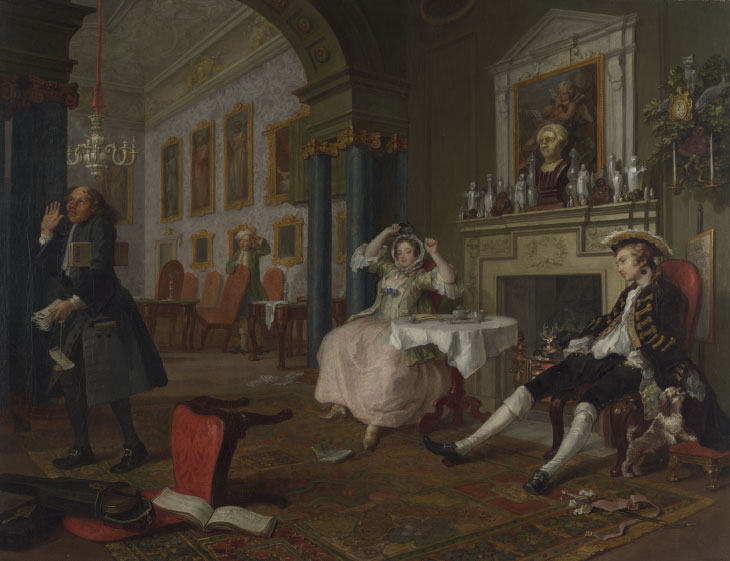
Marriage A-la-Mode, 2: The Tête à Tête (1743–45), William Hogarth. Photo: © The National Gallery, London
Journeys like this, the movement of Hogarth’s characters through and between the stages of a series, are the subject of an exhibition at Sir John Soane’s Museum, London (‘Hogarth: Place and Progress’; until 5 January 2020). The serial satires Hogarth called ‘Modern Moral Subjects’ – the painted and later engraved series A Harlot’s Progress (1732), A Rake’s Progress (1734), The Four Times of Day (1736–37) and Marriage A-la-Mode; and the engraved Industry and Idleness (1747) and The Four Stages of Cruelty (1751) – tell stories that progress because they move forward or shift their scene geographically. What they don’t show is progress in our modern meliorative sense of the word. Things don’t turn out well for most of the characters. Instead, the narrative movements Hogarth dramatises turn on the early modern understanding of a progress as a ritual journey or procession: the removal of Tom Rakewell from his father’s City house to a West End mansion, for instance, or the Harlot Moll Hackabout’s descent from Covent Garden to Bridewell Prison and Grub Street.
Hogarth concretises his characters’ progresses by playing them out along the path of real 18th-century urban processions. Tom has almost reached St James’s Palace for his formal presentation to the king when his debts catch up with him on Piccadilly. In Industry and Idleness, the virtuous apprentice Francis Goodchild sits at the head of one of the most famous ceremonial processions of the day, the inaugural Lord Mayor’s progress from the Guildhall in the City to Westminster and back again. In the same series, the not-so-virtuous apprentice Tom Idle is transported by cart through a ghoulish crowd on the condemned man’s route westwards from Newgate Prison near St Paul’s to the gallows at Tyburn (now Marble Arch). There were symbolic elements to these ritual movements – the journey from Newgate to Tyburn, for example, took the sentenced criminal on a path supposed to recollect Jesus’s journey on the road to Calvary, while the passage of the new Lord Mayor to Westminster mattered because it forged a temporary connection between the two worlds of the City and the court. For Hogarth, though, the real geography of the London progresses was as interesting as their abstract significance, and the journeys he represented shared a common east-west trajectory through the streets.
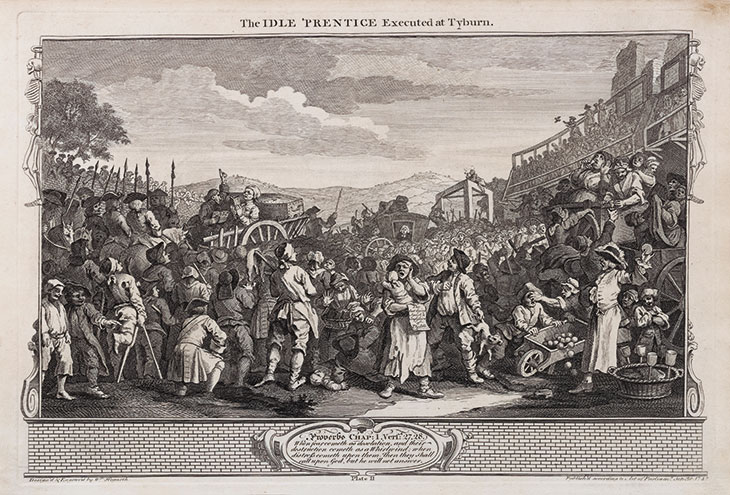
Industry and Idleness, 11: The Idle ’Prentice Executed at Tyburn (1747), William Hogarth. Photo: © Andrew Edmunds, London
Characters in Hogarth almost always find themselves moving from east to west, even if – as in many cases – they circle back eastwards eventually. Tom Rakewell capitalises on his wealthy father’s death to leave his City home and move to a fine house in the West End. Moll Hackabout arrives in Cheapside on the stagecoach from York and moves westward with the decline of her fortunes (from the house of her Jewish keeper to a brothel in Drury Lane), before descending eastwards once more to Bridewell – near Blackfriars – and finally to a penurious death in the squalid area around Cripplegate. The merchant’s daughter who becomes the new Viscountess Squanderfield moves across town to her husband’s mansion on one of the grand West End squares; as their marriage grows sour she starts visiting unsavoury spots in Covent Garden in the area between Westminster and the City; and when the earl is killed she returns to her father’s plain house near London Bridge to die. For Tom Nero in The Four Stages of Cruelty, the journey is shorter – from Holborn and St Giles westwards to Tyburn, then back east to the dissection table in the Company of Surgeons’ premises near Newgate.
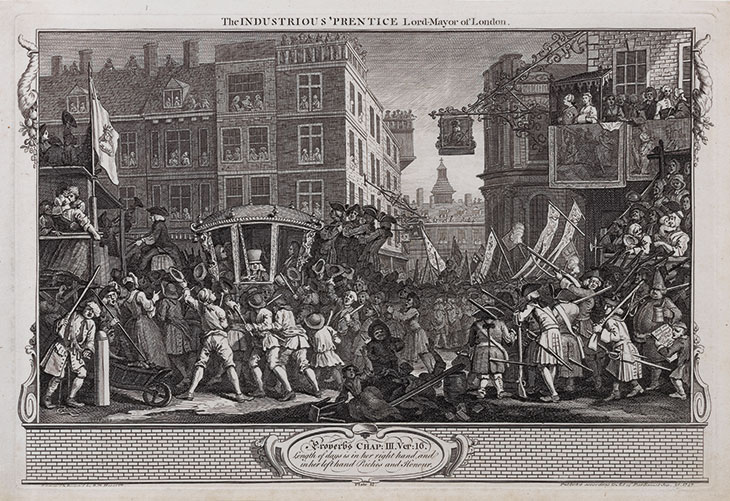
Industry and Idleness, 12: The Industrious ’Prentice Lord-Mayor of London (1747), William Hogarth. Photo: © Andrew Edmunds, London
The east-west progress had a particular meaning in the early modern period as the basis of the translatio studii topos. The topos was a way of understanding human history as a gradual movement of knowledge over time from centres of learning in the ancient ‘east’ – Jerusalem, Babylon, Egypt – to the west, via the empires of Greece and Rome to Renaissance Europe. In the 17th and 18th centuries, the translatio idea emerged in poetry in the form of the ‘progress piece’, a type of poem that traced the historical progress from east to west of a field of human endeavour (music, painting, architecture) or an abstract concept (beauty, liberty).
In Hogarth’s time a number of conventional progress pieces were published, but there were also poems such as The Beeriad: or, Progress of Drink (1736), or The Progress of a Rake (1732) – brought out in anticipation of Hogarth’s series – which travestied the progress trope and turned it to satirical use. The most important of these was Alexander Pope’s The Dunciad (1728), which follows the malevolent Goddess of Dulness – the ruling deity of an empire of bad taste and literary ineptitude – as she progresses westwards along the route of the mayoral procession from her old haunts in the City to invade the realm of polite letters in Westminster. Pope’s version of the progress piece inverts the east-west removal so it becomes a narrative of corruption and decline, the spread of stultifying dullness rather than learning. The individual progresses in Hogarth’s series give us the same inversion, but vividly realised rather than conceptual or allegorical: decline made flesh in the avarice and foolishness of Tom and Moll.
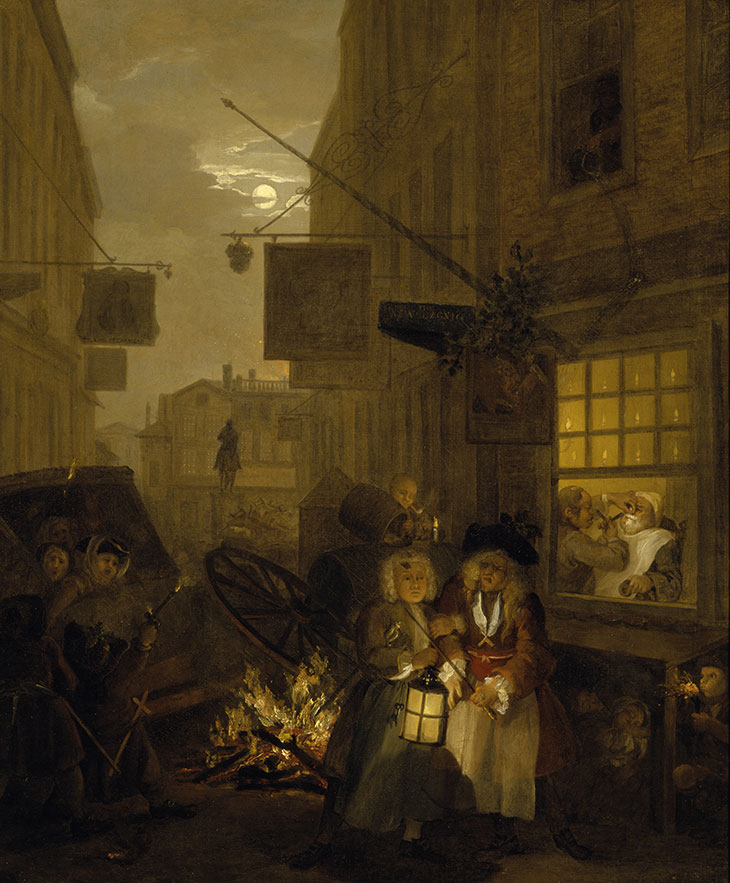
The Four Times of Day: Night (1736–37), William Hogarth. Photo: © National Trust Collections, Upton House (The Bearsted Collection)
Geographical progresses make good frameworks for storytelling because they provide the spatial metaphors we use to think about narrative. Stories follow paths, move forwards or change direction; characters go on voyages of self-discovery; chapters or instalments in a series work like staging posts, breaking up the journey and offering a place to rest. Where something unexpected crops up along the way – a fork in the road; an obstacle; a strange meeting – plot can develop or twist. During the 18th century the motif of the disrupted journey was a favourite trope in English and French novels. In Pierre de Marivaux’s La Voiture embourbée (The Coach Stuck in the Mud; 1714), the mud’s intervention forces a disparate group of coach passengers to stay the night at a local inn and each share a story about themselves. Tobias Smollett’s Humphry Clinker (1771) introduces us to the title character via a chain of events involving an overturned coach, an unruly dog and an impertinent footman. (By the end of the century halted or crashed coaches could be a jokey nod to the reader: Austen, for instance, makes brilliant use of the trope to kill off the husbands of her intolerable female protagonists in her teenage novel Love and Freindship.)
In Hogarth’s series, broken coaches can work like grander versions of the broken chair motif or the smashed crockery set; they are part of a rhetoric of discord, there to show that something has gone very wrong. This is the case in the Night painting of The Four Times of Day, in which a coach comes off its wheels in the midst of a chaotic brothel-lined street, the bellowing passengers ignored by the sinister barber performing his ministrations in the window opposite; and in the third scene of The Humours of an Election, in which the shattered axel beneath Britannia’s coach – ignored by the dissolute card-playing footmen in front – points to the brokenness of the electoral system and the way it gambles with cash and trust. But, as in the novels, coaches can also be used to enable narrative progress – to kickstart plot or signal a change in direction. It’s no coincidence that we first see Moll stepping off the York stagecoach, as both the beginning of her story and the end of it. And Tom’s triumphant progress towards St James’s starts its about-turn eastwards when his chair is held up by officers arresting him for debt in the middle of the street.
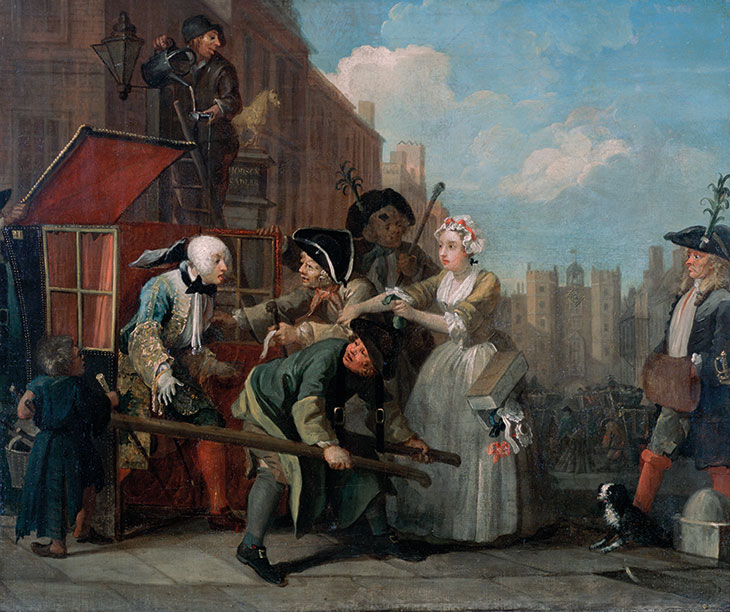
A Rake’s Progress, 4: The Arrest (1734), William Hogarth. Photo: © The Trustees of Sir John Soane’s Museum
Dynamic objects – even when halted – keep Hogarth’s series moving. But building a story arc across discrete images requires doing work in the spaces between plates, asking viewers to piece together the path taken from one place to the next. Aftermath scenes are everywhere in Hogarth: there is the aftermath of the duel in Marriage-A-la-Mode, where the two swords – one bloody, one clean – are scattered like used theatre props, and the countess’s lover can be seen escaping half-naked out of the window stage-left; in The Four Stages of Cruelty there is the freshly murdered housemaid, whose tragic mistake we have to reconstruct from a letter fragment and the stolen goods by her side; and in A Harlot’s Progress the delicate ellipsis Hogarth instates between Moll’s arrival in London and her situation in the second plate. Scenes like this are economical because they allow images to speak twice, both relating effects and insinuating causes.
But time does strange things in Hogarth’s paintings: it can contract and compress, so that events set off by one another sequentially look like they’re occurring simultaneously, all in the split-second moment the artist captures. In The Four Times of Day: Noon, a young man surprises a maid by grabbing her breast and kissing her, causing her to tilt the pie she’s carrying and spill its hot liquid; her spillage hits a weeping ginger-haired boy who drops and smashes the plate of food in his hands, where it is eagerly stolen from the ground by a hungry girl. The train of slops waterfalls towards us down the picture plane, the copper circle of the pie mirroring the shattered copper circumference of the boy’s plate to connect cause and consequence together as one. In the final scene of The Four Humours of an Election, similarly, we see the new Tory MP on his ceremonial chair lurch sideways into the air, hat flying, just as – even though logically we know it must have happened already – we notice what has caused his unseating: one of his chair carriers receiving an accidental backhander to the temple from a hinged stick. The scene reflects back on a similar moment in the first picture in the series, where a secretary for one of the candidates has been struck on the forehead by a flying brick and is sent spinning backwards on his chair, arms flailing. On the floor, about to be crushed by the brick and his weight, is a lobster sprawling on a stack of plates next to a delicate array of vegetables, presented as if in a Dutch still life. Sudden violent motion – set in train by the brick-lobbing protestors outside the window – collides with an emblem of static pictorial composition, time still and time still moving.

The Humours of an Election, 4: Chairing the Member (1754–55), William Hogarth. Photo: © The Trustees of Sir John Soane’s Museum
Hogarth wasn’t alone in experimenting with the temporal possibilities of the series. In his pencil studies for The Anatomy of the Horse (1766) – part of an exhibition currently at Milton Keynes Gallery (‘George Stubbs: “all done from Nature”’; until 26 January 2020) – George Stubbs presents a horse in progressive states of dissection from three different perspectives. We follow the path of his scalpel as it strips skin and layers of muscle from the animal’s body to leave just the skeleton standing. But what looks like a linear progress is actually an oscillation: in the Anatomy the three skeletal perspectives precede the dissected views, so that the frame of the animal is marvellously re-fleshed and brought to life before it is stripped down again.
In the ‘Modern Moral Subjects’, though, manipulation of linear form goes beyond inverting orders of occurrence or representing successive events as happening simultaneously. In real life, the series argue, there is no such thing as a single story or a single progress: nothing happens to one person without touching on many other people in unexpected ways. Charles Lamb, one of Hogarth’s best early critics, recognised this as a Shakespearean quality in the artist’s work, a ‘comprehensiveness of genius’ capable of cramming ‘into one small canvas so many diverse yet co-operating materials’. The ‘admixtures’ of seriousness and mirth in Shakespeare and Hogarth’s scenes, Lamb argued – their ability to paint a world that was both funny and sad simultaneously, a world in which one person’s tragic event could be another’s cause for laughter – brought them close to ‘the drama of real life, where no such thing as pure tragedy is to be found’. Hogarth’s prints were like Shakespeare’s tragicomedies: they expressed, as Samuel Johnson wrote of the plays, ‘the course of the world […] in which, at the same time, the reveller is hasting to his wine, and the mourner burying his friend’.
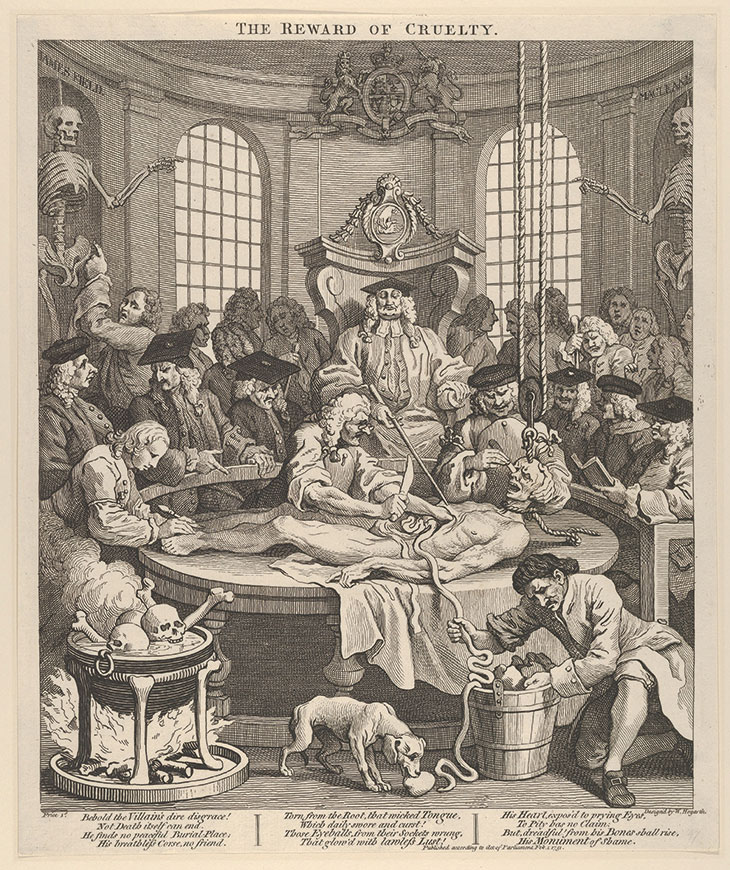
The Four Stages of Cruelty, 4: The Reward of Cruelty (1751), William Hogarth. Metropolitan Museum of Art, New York
This comprehensive effect is clearest in Hogarth’s group scenes, which, as Frédéric Ogée notes in his essay for the catalogue of the upcoming exhibition, play with the fashionable idea of conversation to reveal tension and contradiction in the way different characters respond to an event. For the preoccupied-looking curate in attendance at Moll’s wake in the final Harlot image, the gathering round her coffin is an opportunity to explore the territory beneath another prostitute’s skirts. In the last plate of The Four Stages of Cruelty, the casually chatting trainee surgeons at the back remind us that one man’s brutal live dissection is another’s boring morning lecture. Large crowd scenes, meanwhile, multiply and refract the possibilities of response. Tom Idle’s arrival at Tyburn in the 11th plate of Industry and Idleness is brought into contact with a thousand other individual progresses, most of which have only a passing connection to his tragedy or seek to turn it to their own advantage. A woman in the foreground knocks her husband to the ground, almost crushing their child beneath him, as her rival tries to remonstrate; on the cart to the right of the picture, a group of bawdy women are getting drunk while others pass cups up to them for filling; and for the various fruit-sellers and ‘Last Dying Speech’ hawkers, Tom’s loss is not only their gain but their livelihood.

A Harlot’s Progress, 6 (1732), William Hogarth. Photo: Royal Collection Trust/© Her Majesty Queen Elizabeth II 2019
The composition of the scene – Tom’s cart on the left of the picture and in the middle-distance, with the hawkers, brawlers and drunkards in front and centre-stage – shows his tragic journey almost overwhelmed by the ‘drama of real life’ it belongs to. In this tangled web, no single progress can proceed without shaping the course of another progress, or crashing into its path. For Hogarth, this was where the interest lay. His series give us no stately uninterrupted processions in the early modern civic vein: they are teeming with simultaneous divergent possibilities, paths crossing, paths cutting off other paths, paths not taken.
‘Hogarth: Place and Progress’ is at Sir John Soane’s Museum, London, until 15 January 2020.
From the October 2019 issue of Apollo. Preview and subscribe here.














![Masterpiece [Re]discovery 2022. Photo: Ben Fisher Photography, courtesy of Masterpiece London](http://zephr.apollo-magazine.com/wp-content/uploads/2022/07/MPL2022_4263.jpg)
Suzanne Valadon’s shifting gaze